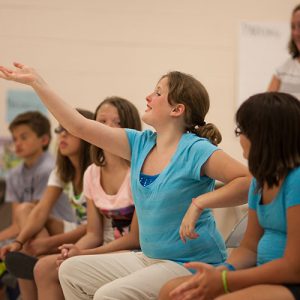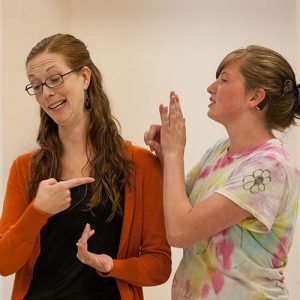Kimberly Wolbers was close to getting a degree in accounting when she took time off to work with disabled individuals at Camp Courageous. There she encountered a three-year-old deaf boy who didn’t know any sign language. And neither did she.
Wolbers was at a loss.
“He had no language through which to communicate,” she said. “The first sign we learned together was spaghetti.”
Her experience at Camp Courageous set Wolbers on a path that would eventually lead her to UT’s College of Education, Health, and Human Sciences as an associate professor of education for the deaf and hard of hearing.
While working on her dissertation in graduate school, Wolbers developed the Strategic and Interactive Writing Instruction (SIWI) concept, which promotes language and writing skills among deaf and hard-of-hearing (DHH) children.
“Learning to read and write is more difficult for deaf and hard-of-hearing children,” Wolbers said. Most tend to lag in literacy progress throughout their school years.
According to Wolbers, previous research indicates that the median DHH student reads at a fourth-grade level upon graduation from high school, and 30 percent are functionally illiterate.
The Method
 Wolbers developed SIWI to give teachers the tools and instructional approaches they need to improve the development of language and literacy in their DHH students. Three key components work together to drive the process.
Wolbers developed SIWI to give teachers the tools and instructional approaches they need to improve the development of language and literacy in their DHH students. Three key components work together to drive the process.
The first element emphasizes strategic instruction for writing, where students learn the tactics used by expert writers.
“Novice writers may not have good strategies for planning and organizing when writing,” Wolbers said. “We explicitly teach students to think about their audience and purpose while brainstorming ideas.”
Teachers are encouraged to use graphic organizers, or scaffolds, to serve as visual representations of the writing processes, strategies, or skills. “We guide them in the process of continually rereading what they have written to spur necessary revisions or edits,” Wolbers said.
The second element, known as interactive instruction, promotes high engagement while working as a group to write for a real audience with real purpose.
“For example, if students and teachers are working on persuasive writing and the students have an interest in going on a field trip that requires administrative approval, they might choose that field trip as a topic and the principal as an audience,” Wolbers explained.

Teachers and students will then share their ideas and decide together what actions they will take once the writing process begins.
The third element of SIWI is teaching students about the two different languages they use—American Sign Language (ASL) and English.
Students are taught to identify when one language is being used versus the other and to compare the grammatical similarities and differences. Wolbers said this helps students learn more about the structure of the two languages as well as ways to better translate between the two.
Students also acquire ASL by interacting with fluent users of the language. This is how most people learn their first language.
“English is difficult for deaf children because they can’t hear the language being spoken,” Wolbers said. “In SIWI, we reread the revised English text often and find that students begin to pick up on English grammatical patterns that we have not explicitly taught.”
Proof of Concept
Wolbers and her research partner, Hannah Dostal of the University of Connecticut, are conducting a controlled SIWI trial in fifteen classrooms from twelve educational programs in eight different states, which is undertaken with the help of a $1.16 million, three-year grant from the Institute of Education Science. The goal is to determine if their innovative approach leads to significant improvements in DHH students in grades three through five.
The small and scattered DHH population was one of the problems the researchers faced when putting the trial together. Because the disability is not a common occurrence, study sites were geographically far apart. Technology helped bridge the gap for classroom observations, which are completed with two-camera systems that capture the teacher as well as the students.

Teachers use the SIWI instructional materials, including visual organization tools and student cue cards. They also have access to a SIWI website for additional resources and video clips.
Wolbers feels one of SIWI’s biggest strengths is that it is a framework for instruction, not a fixed curriculum. This allows teachers of different grades and content areas to work toward objectives.
Results from prior SIWI studies show the participating students make gains in language, reading, and writing assessments.
Wolbers recently hosted a group of teachers from around the country for a weeklong SIWI workshop. They visited the Tennessee School for the Deaf in Knoxville to practice guided writing instruction with deaf junior campers. Together, they wrote a newsletter about their camp experiences to share with family and friends.
Those teachers have already begun to implement SIWI in their respective classrooms. They will collect language and literacy data from their students throughout the school year as part of the randomized control trial.
In the future, Wolbers hopes to replicate her study in grades three to five to see if SIWI can be successful when broadly implemented. She would also like to expand the program to include more levels and other content areas.
Thinking back to her time with the young boy at Camp Courageous, Wolbers doesn’t know if there was much else she could have done to help him at the time.
“But that camp experience has certainly impacted my work,” Wolbers said. And that work has already begun making an impact on deaf and hard-of-hearing children nationwide.

